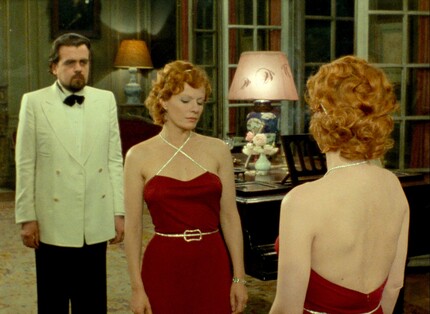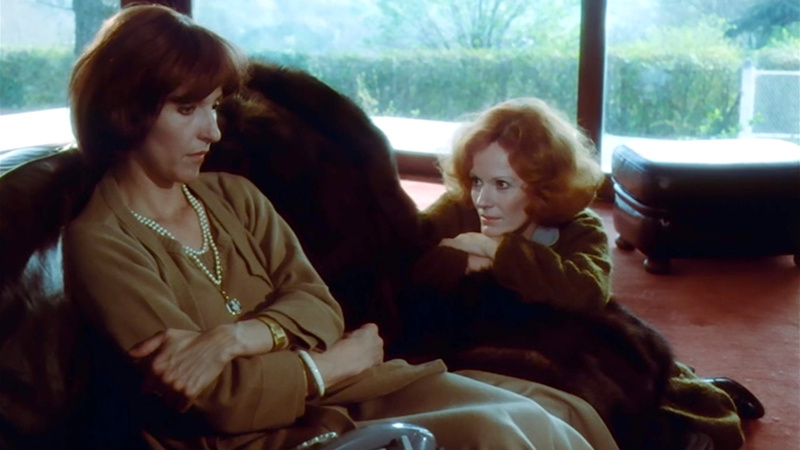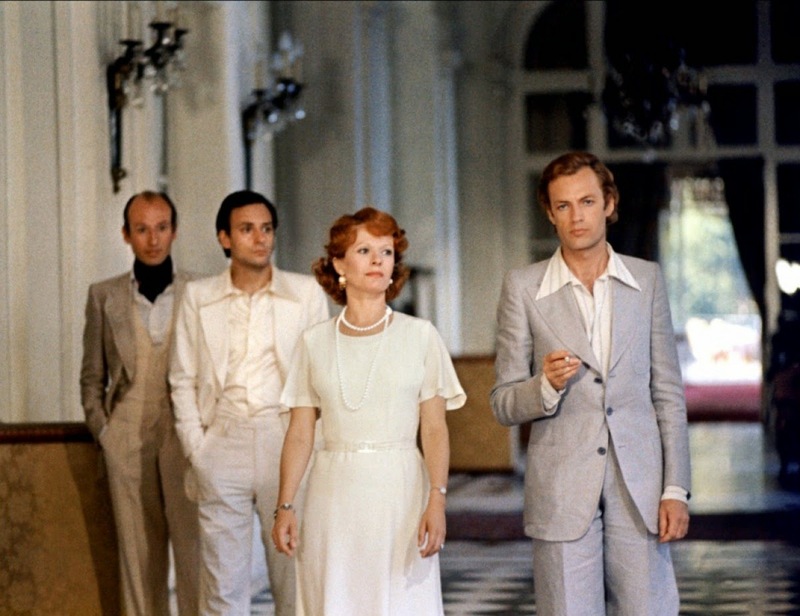Blu-ray Review: INDIA SONG and BAXTER, VERA BAXTER, Marguerite Duras Celebrated by Criterion

Marguerite Duras was a renaissance woman. An author, playwright, screenwriter, and filmmaker, her life and work spanned the 20th century and yet she is often forgotten by cinephiles, or at least remains something of a footnote, mainly known for her screenplay for Hiroshima, Mon Amour and her novel The Lover, which was made into a film in 1992. But she also made almost 20 films, two of which are finally getting a well-deserved Criterion release, India Song (1975) and Baxter, Vera Baxter (1977)
While separated by a few years, the films could be considered companion pieces. Both look at the lives of women trapped in loveless marriages, who look to the outside for intellectual and physical stimulation. Both could be considered about female jouissance, or perhaps more accurately, the lack thereof, and the emptiness of the lives of bored, rich housewives. Somewhat dated, perhaps, in that it is hard to have a lot of sympathy for women who had all the necessities of life more than taken care of.
And yet, these women's story is one that still haunts cultures and societies today. A cage that is large and gilded is still a cage. The women of these films might want for little, at least in terms of the material and the basic necessities of life, but they are still in a prison. More than that, Duras was working in a style that would be a signature of experimental feminist cinema of the 1970s, one that stemmed from the female gaze and female soundscape, expressions of the internal imagination and experience unlike what had been seen before in cinema, in France or anywhere.
India Song takes moments from the life on Anne-Marie, wife of the French ambassador to India in the 1930s. Seemingly with the knowledge and unspoken approval of her often absent husband, Anne-Marie carries on numerous affairs, all the while the house she inhabits seems to be decaying - from the inside out, or from the outside in, it's hard to tell. But while the affairs might give her a temporary respite, it seems only to delay the inevitable decay of herself, as any possibility of a life beyond her status as a woman fades quickly.
The space that Anne-Marie occupies is one in which the layers of dust can be seen when you look through the sunlight, or you proverbially run your finger along the tabletop - not even she can be bothered with small acts of maintaining an existence beyond the necessity. Her love affairs stem not necessairily from desire, but boredom; or perhaps more accurately, the desire to feel something rather than nothing. These men, it seems, are not predators using her, but perhaps caught in the same circular ennui. A story is being told in voice over, a legend of a woman and her love gone wrong. But is this Anne-Marie, or a story she clings to, in her quiet desperation?
But it's not so much the story of the film, but the style and tone through which Duras asks us to understand the story, that makes it stand out. Long, languid shots of Anne-Marie and her lovers walking down a hall, as if with no point of departure or destination. Slow pans across rooms of them in their evening clothes, as if it's the only way to tell the change of time. Looking at them through lenses and mirrors, all the while the conversation happens around them, Everyone talks to Anne-Marie, or about Anne-Marie, or screams for her across the terraces and woods and waters that surround this building on the brink of collapse? Are we those voices judging anne-Marie without hearing what she herself has to say? Duras fashions a deep and longful meditation on the nature of existence, of those kept in these gilded cages, and us who judge them too harshly.
Baxter, Vera Baxter is a spiritual cousin to India Song. We meet Vera (Claudine Gabay) at first not through herself, but through other people talking about her. This time, in a small café, in the town where she might be shortly moving. Her husband, a wealthy man who frequently has affairs, is keen to rent a large estate. And it seems Vera might have a lover as well, Cayre (Gérard Depardieu), and he asks her whereabouts, while the staff and clientele talk, effectively, behind Vera's back. When we meet her, she is in this possible rental home contemplating how she ended up her, relating intimate information first to one woman, then another, again in a world-weary manner.
This time, the house is in good shape - and a modern home, with modern furnishings. It feels cold and empty and metallic, a contrast to Vera herself in warm colours, seated on a leather chair that suggests a psychiatrist's office. Contrasted as well is the relatively cheery music, the lovely seaside locale, against the seriousness and intimacy of Vera's conversations and confessions. It seems Vera's husband has offered someone money to become Vera's lover - either because he wants her to keep busy without him, or feels it's someway of fulfilling his 'husbandly duty'. But Vera does not know how to cope with this situation. All the while, the score seems to repeat a song - sometimes soft, sometimes loud, but somehow it never gets tired, as each time it finds its rhythm met by the story.
Rather than being spoken about, most of the film highlights Vera's voice and perspective - her history of being moved from her family's home to her husband's, almost like chattel (which is likely how she was seen, high-class but still chattel). A husband whose only success comes from her family's money, a husband who still abuses his position despite what he owes to her, and how that has led her to her current state of quiet desperation. Should she continue with this affair, again one spured by men for want of money? Is this all she has to look forward to? Through slow pans, minimalist set decoration, and a character who barely moves from one position, Duras asks the audience to truly listen to Vera: despite what seems like a charmed life, it is, like Anne-Marie's, a gilded cage.
The 2K digital restoration is, as always, excellent: the richness of the colours especially in India Song, of the costumes and scenery, lend to the texture of the story. At the same time, it keeps the print film aspects that ask us to look deeper between the frames, as it were, not only visually but aurally. The unsompressed monaural sound, in both films where the dialogue counts for so much, feels both as if you are in the room hearing the gossip (in the case of India Song) or the confession (in Baxter, Vera Baxter). It is inescapable and compelling in its quality.
Duras herself was frequently in front of the camera on French television in the latter 20th century, due to her popularity and her status as a literary and cinematic personality. An excerpt from a television program features Duras discussing her idea of the character Vera's backstory: a woman who was sent away by her parents ot boarding school, then sent away again to be married young, a woman who was, in effect, never allowed to be herself. Duras sees this as the fate of many women for decades who were forced to subsume themselves to men in patriarchals cultures. While perhaps not a surprising relevation, it's an interesting peek into Duras's process for character and story creation. Likewise, an excerpt from another programme with an interview with actress Seyrig, has Seyrig discussing how she saw Duras work during the production of India Song; how Duras had been told she must have a co-director (despite having already made five films), and how Seyrig herself encourage Duras to be more assertive, as any male director would. Seyrig notes how Duras had an uncanny ability to understand the rhythm of music and sound, to marry it perfectly to image.
The documentary Marguerite as She Was, including interviews with former crew members and friends, as well as featuring old footage interviews with the filmmaker herself, gives us a more intimate portrait of Duras both as a filmmaker and a person. She shares her thoughts on maternal love, we have insight into her rather unusual childhood of being raised in Vietnam (where, despite having at least racial privilege if not financial, she rarely saw herself as French, in her words), her rather difficult relationship with her mother, and after her early death, having to more or less fend for herself. There are home movies and photos of her as a child, of her own children, footage of her directing one of her plays, and her thoughts on the meaning of happiness. Duras shared so much of herself and this documentary shows her layed quite bare.
Another documentary looks in detail at the filmming of India Song. Interviews with producer Stéphane Tchal Gadjieff, director of photography Bruno Nutyyen, and script supervisor Geneviève Dufour, highlight how Duras looked at the places and people she was filming and incorporated elements in a unique and original way. While she might not have had extensive technical knowledge, they recall that Duras always knew what questions to ask in order to understand and decipher how she could get the shot she wanted with the tools and people on set.
Author and scholas Ivone Margulies's essay reveals that one of the reasons Duras began making films was that she was frustrated with how other directors interpreted her writing. While her films were visually stunning and radical in form, Duras wanted audiences to listen, perhaps more than see; in effect, listen to women's voices, not to just look at us (an effort also underway in the films of UK academic Laura Mulvey, working at the same time). The essay especially goes into depth about India Song, Duras's goals and techniques to convey this story in a different way, particularly through her use of sound and voice-over dialogue. It also puts Baxter, Vera Baxter in context with Duras's other work at the time, how she found a place for what she was trying to acheive in theeatre, and how the different art forms she chose worked with each other.
The disc set of Two Films by Marguerite Duras will be released on February 28th.








